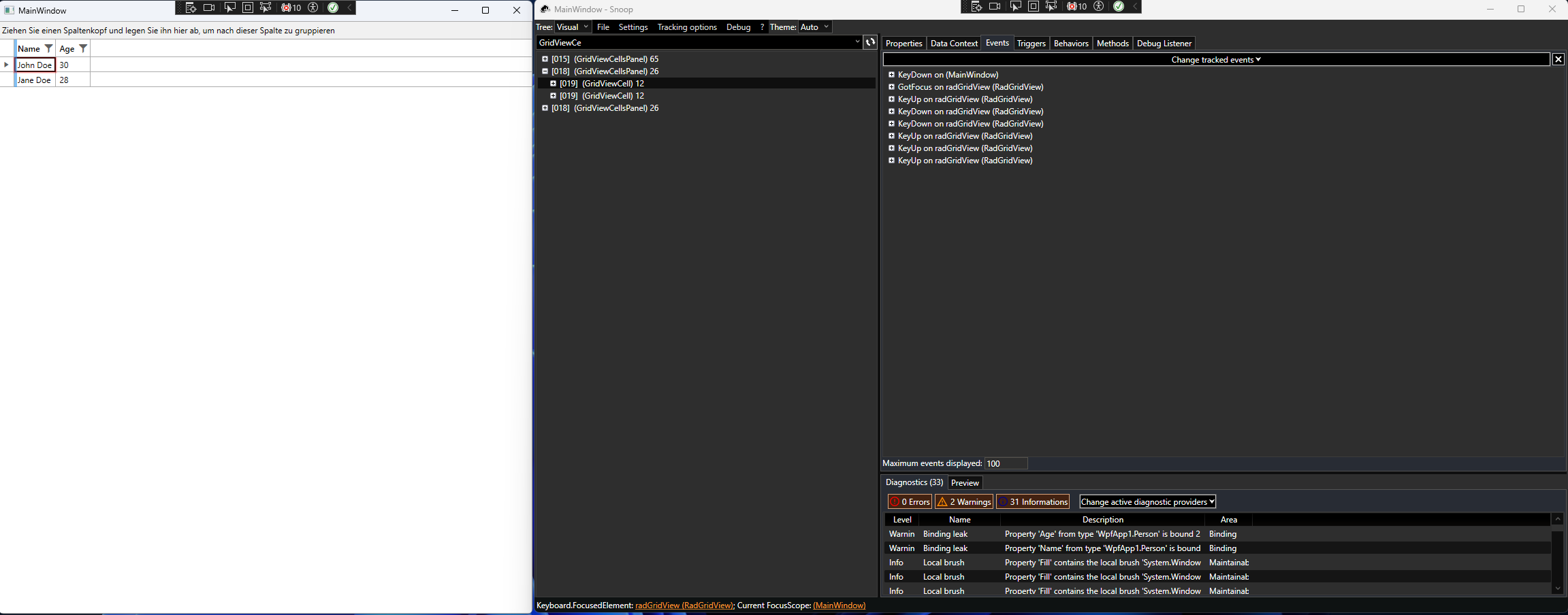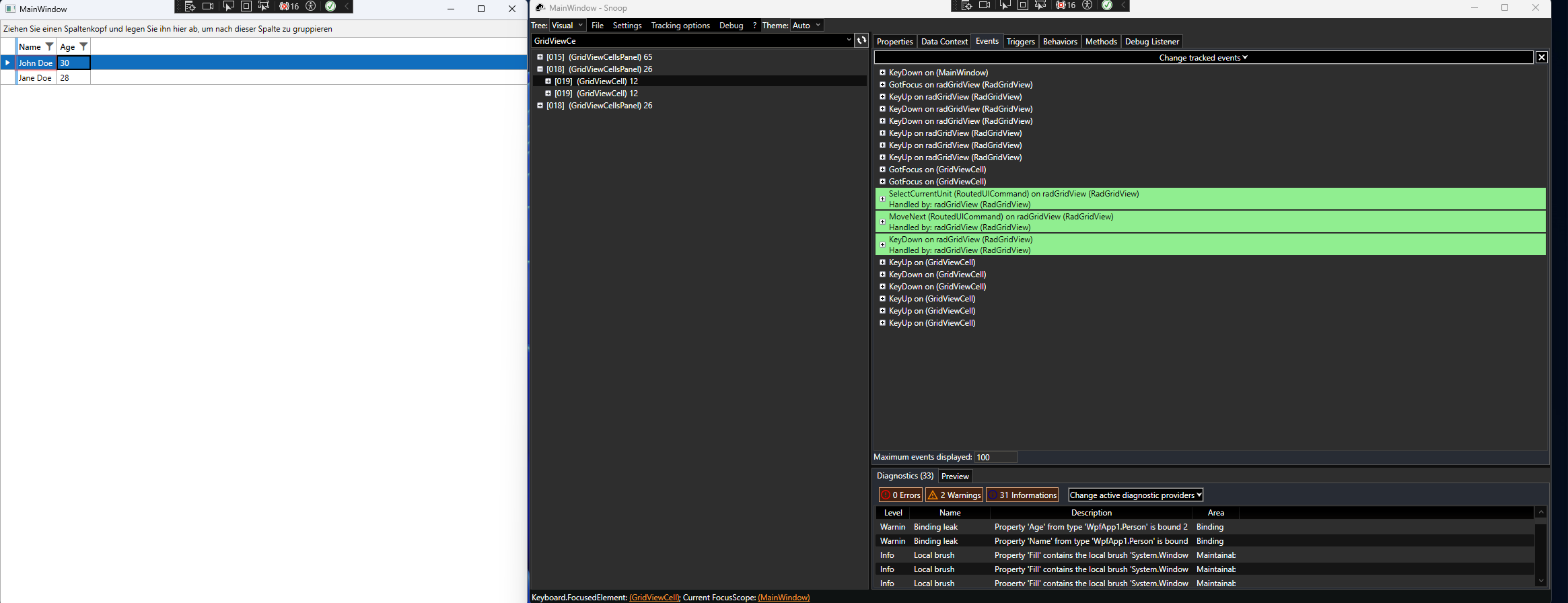InvalidCastException is thrown when the DropIndicatorThickness property of the GridViewHeaderCell is set. Or whenever the DropIndicatorBrush property is accessed. This happens when using the Windows 7 theme. Also, the EnableColumnVirtualization property should be set to False.
System.InvalidCastException: 'Unable to cast object of type 'System.Windows.Media.LinearGradientBrush' to type 'System.Windows.Media.SolidColorBrush'.'
To work this around, you can use an implicit style targeting the GridViewHeaderCell in order to set its DropIndicatorBrush to a SolidColorBrush value.
<telerik:RadGridView.Resources>
<Style TargetType="telerik:GridViewHeaderCell">
<Setter Property="DropIndicatorBrush" Value="White" />
<Setter Property="DropIndicatorThickness" Value="10" />
</Style>
</telerik:RadGridView.Resources>
Column groups may disappear when the RadGridView control is hosted in a TabItem of TabControl. These column groups can disappear when new GridViewColumnGroup instances are created.
Furthermore, resizing a column of RadGridView will result in a NullReferenceException.
To work this around, set the EnableColumnGroupsVirtualization property of RadGridView to False.
Currently, when you cancel the Filtering event the field filter (displayed when FilteringMode="FilterRow") will clear any entered text and the funnel icon won't change its color (like when the filter is active). Add an option in the Filtering event, similar to the Sorting event which allows you to manually set the sorting state of the column which will affect the UI (showing and changing the sort indicator icon).
In the case with the Filtering event, there should be an option if the funnel icon should be highlighted. In other words the setting should allow you to manually say if the filter is active or not. Also, the input text in the field filter should be preserved and possible an option to change this value may be added in the event arguments. This will allow you to implement custom filtering and keep the UI state of the field filter.
The column group headers are not displayed when the DisplayIndex property of the GridViewColumn objects is set before the control is loaded.
To work this around, you can set the DisplayIndex of the columns after the RadGridView is loaded.
The UI is not updated when an item is replaced in the bound ListCollectionView.
Workaround: Remove the item and add a new one.
Empty cells appear when the RadGridView contains many cells in the viewport and the view gets resized.
To work this around you can extract and modify the ControlTemplate of GridViewCell, in order to set the MinHeight property of the "PART_ContentPresenter" element to a number close to the RowHeight of the RadGridView control.
In the Office2019 theme, the RadGridView's ScrollBar elements should have transparent background by design. This is the track's background shown behind the thumb element that allows drag-to-scroll. Currently, the ScrollBars have a gray background.
To work this around, you can define an implicit Style in the App.xaml that targets the GridViewScrollViewer control. Then, set its Background property.
<Application.Resources>
<ResourceDictionary>
<ResourceDictionary.MergedDictionaries>
<ResourceDictionary Source="/Telerik.Windows.Themes.Office2019;component/Themes/System.Windows.xaml"/>
<ResourceDictionary Source="/Telerik.Windows.Themes.Office2019;component/Themes/Telerik.Windows.Controls.xaml"/>
<ResourceDictionary Source="/Telerik.Windows.Themes.Office2019;component/Themes/Telerik.Windows.Controls.Input.xaml"/>
<ResourceDictionary Source="/Telerik.Windows.Themes.Office2019;component/Themes/Telerik.Windows.Controls.GridView.xaml"/>
</ResourceDictionary.MergedDictionaries>
<Style TargetType="telerik:GridViewScrollViewer" BasedOn="{StaticResource GridViewScrollViewerStyle}">
<Setter Property="Background" Value="Transparent"/>
</Style>
</ResourceDictionary>
</Application.Resources>
The issue seems to occur when a `RowHeight` is set in combination with `UseLayoutRounding`.
If you "remove" one of them, the last row appears.
Version of dlls 2024.1.130.70

Allow check/uncheck of the currently focused item using the keyboard (by pressing the Enter or Space key).
Dear Telerik Support Team,
I am encountering an issue with the RadGridView control in my application, which is impacting the usability for users relying on screen readers. Below, I have outlined the details of my development environment, the problem, and attached a sample project demonstrating the issue.
Issue Description:
In the attached sample project, I have implemented a simple RadGridView without any custom styling and populated it with sample data. I have observed that the focus behavior is inconsistent, particularly with the first cell in the RadGridView. When attempting to focus the first cell, only the cell itself receives focus, unlike subsequent cells where both the cell and the entire row are focused. This inconsistency results in screen readers failing to read out the content of the first cell, while they correctly read the contents of all other cells.
Upon further investigation using the Snoop utility to explore the visual tree, I noticed that the GotFocused event for the initially focused cell identifies it as being of type RadGridView, whereas, for other cells, the type is GridViewCell. This discrepancy seems to be at the root of the issue.
Attachments:
I have included a simplified, runnable standalone application that reproduces this behavior. Please find the sample project attached to this ticket.
I believe this might be a bug affecting the accessibility of the application, and I would greatly appreciate your guidance on whether this is a known issue with a workaround or if there's a fix available.
Thank you for your assistance.
Best regards,
Christian
First Tab:
Second Tab:


